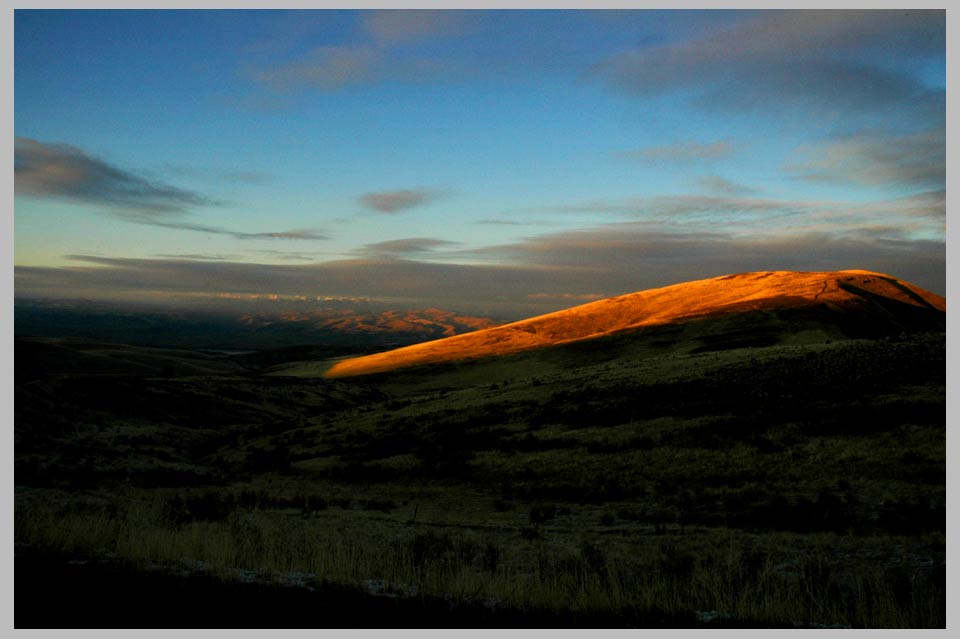
Snake West Rim, view Northwest . . .
On the road in the Northwest of America.

Snake West Rim, view Northwest . . .
On the road in the Northwest of America.
Nothing as Resource . . .
Many nowadays come to the empty spaces of areas like
the vast and magnificent Snake River Gorge much like pilgrims
of old journeyed across entire continents to cathedrals: in search
of healing, in search of the divine. And now, just as in the past,
contemporary pilgrims—if I may use that word here in the sense
of its root meaning of 'wanderer'—also seek perhaps healing, a
sense perhaps of the divine. But they also seek, it seems to me,
simply a period of rest or refuge from the noise and forced rhythms
of present-day Western culture.
Indeed, silence has in many parts of the world become an
endangered species of experience.
Think of it. No one actually set out to design the contemporary
soundscape; it is entirely an an unintended by-product, an
afterthought of Euro-America's wild and crazy 100-year-old
petrochemical experiment. Cars, engines, mechanized movements
of every description criss-cross the streets of almost every city or town
of any size around the world, and they are all powered by some kind
of remarkably noisy rockoil motor.
What has all this corruption of the sonosphere done to us? I would
guess that, as with all loss of purity generally, it has made us less
sensitive. How could this be otherwise? As environments become
more hostile, we naturally contract behind ever-tighter real or
psychological walls of self-protection. (To see this happen in a
young child is a brutal and terrible thing since it signifies the
beginning of the end of learning.) And, of course, it has made us
far less sensitive to musical sound in particular. The Arts pages
in North American newspapers complain habitually of the decline
of orchestras and classical music. But the real decline, it seems to me,
began many years ago with the loss of the deep grounding of rich,
natural, acoustic sound in an uninterrupted ambient silence. And
with the ever-rising levels of noise, our own voices have become
more strident, and louder. And so the music we make and choose
to listen to reflects this. A Stradivari fashioning his or her instruments
in contemporary downtown New York? No way. Not possible.
Mechanical, artificial, electronic sounds without the slightest trace
of natural sympathetic resonance. Yes. That's possible. And
musicians playing so loud they wear protective ear gear.
Yes. That's possible, too. It's a fact.
Silence in Snake River country is except for the occasional passing
car or truck very much alive and well. So much so, that for the
unprepared it may confront one with something of a shock. An
uncomfortable feeling, at first. Something we can't quite put our
finger on. And then. something remarkable may happen. A raven
honks in low, slow groups of fours and fives as it flies with audible,
steady wing beats due east across the Gorge. We are startled by the
presence of the sound, and listen to it disappear. Then, there's a
loosening of the shoulders, a lengthening of one's stature, a release
of an almost chronic holding of the breath. And we become like a string
which was too tightly strung and that now little by little unwinds and
lets go of its tension into the emptiness of the Gorge. Yes. Nothing
as resource. That's possible.
NEW:
To view / purchase
different sized prints of this image at the
PhotoWeek Store click here.
view as SLIDESHOW
|
[http://www.shutterfly.com/pro/cliffcards/photoweek]
| back to Picture/Poems:
Central
Display |
go to P/P Photoweek: Archive
|| or go to last week's PhotoWeek pages |
|
Map
|
TOC:
I-IV |
TOC:
V-VIII |
Image
Index
|
Index
| Text
Only
| Download
Page |
Newsletter
|
About
P/P |
About
Cliff
Crego |
Photograph by Cliff Crego © 2007 picture-poems.com
(created: XII.16.2007)